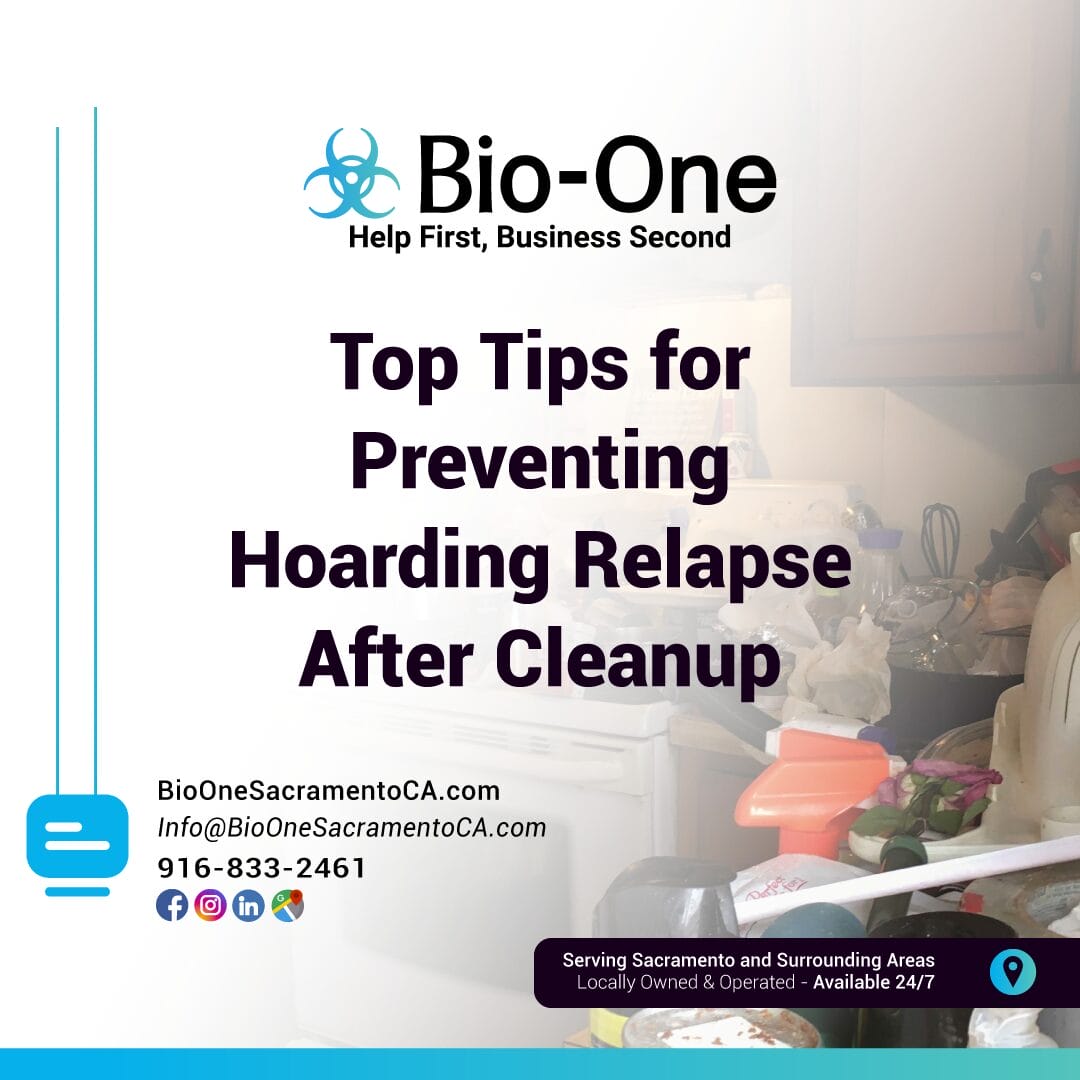
Undergoing a hoarding cleanup is a significant step toward improving your living environment and overall well-being. At Bio-One of Sacramento, we understand the challenges involved in reaching this milestone and the ongoing effort it takes to maintain it. Preventing hoarding relapse can be difficult, especially when emotional and psychological factors are at play, but with the right tools, support, and mindset, a clutter-free and healthy home is achievable. Here are our top tips for keeping your home organized and preventing a return to hoarding behaviors.
1. Create and Stick to a Maintenance Routine
Establishing a consistent routine is one of the best ways to prevent clutter from building up again. Start by dedicating small amounts of time each day or week to tidying up specific areas of your home. For example:
- Spend 10 minutes each evening clearing countertops or putting away loose items.
- Set a designated day for sorting mail and paying bills to avoid paperwork piling up.
- Regularly organize closets and storage spaces to ensure they don’t overflow.
Routines not only prevent clutter but can also create a sense of stability and accomplishment.
2. Adopt the One-In, One-Out Rule
When bringing a new item into your home, make it a habit to remove something old. For instance, if you buy a new piece of clothing, donate or dispose of one you no longer wear. This practice ensures you maintain balance in your possessions and prevents unnecessary accumulation.
3. Set Clear Boundaries for Your Space
Define clear purposes for each room or area in your home. For example, keep the kitchen for cooking and eating, rather than using it as a storage space. Having designated areas for specific functions can help you stay organized and prevent items from creeping into spaces where they don't belong.
4. Be Mindful of Emotional Triggers
Hoarding behaviors often stem from emotional stress, trauma, or attachment to items. Pay attention to triggers that might lead to impulsive buying or difficulty letting go of possessions. Whether it’s a sentimental association or fear of future scarcity, recognizing these triggers can help you manage them in a healthier way. Journaling about your feelings or talking to a trusted friend can also provide clarity and support.
5. Seek Professional Help Without Hesitation
If hoarding feels overwhelming and difficult to manage on your own, reaching out to a therapist or counselor can be a life-changing step. Mental health professionals are trained to help individuals understand the root causes of their behaviors and develop effective coping strategies. Seeking therapy is a sign of strength, not weakness, and plays a crucial role in fostering personal growth.
It’s important to break the stigma surrounding mental health support and recognize that everyone deserves guidance in their struggles. Taking this step can empower you to regain control and create a healthier, more organized living environment.
5. Practice Decluttering Regularly
Periodic decluttering is essential to keep your home clear and manageable. It doesn't have to be overwhelming! Start with small areas like a drawer or shelf, and slowly work your way up to larger spaces. Ask yourself these questions as you sort through items:
- When did I last use this?
- Does this item bring me joy or serve a purpose?
- Would I truly miss it if it were gone?
Donate items in good condition to local charities, which can make letting go feel more positive and purposeful.
6. Build a Support System
Lean on family, friends, or community groups who understand what you’re going through. Having supportive people around can make all the difference. They can help hold you accountable, assist with organizational projects, or simply offer encouragement when you need it.
Online or in-person hoarding support groups are also available and can provide a safe space to share experiences and gain insights from others who have faced similar challenges.
8. Celebrate Small Wins
Maintaining a clutter-free home isn’t about perfection; it’s about progress. Celebrate small wins along the way, like clearing out a single drawer or completing a task on your maintenance routine. Recognizing these achievements can boost your confidence and motivate you to keep going.
9. Replace Old Habits with Healthy Ones
Instead of relying on shopping or acquiring items for comfort, try incorporating new activities into your routine. These might include:
- Taking walks or exercising to relieve stress.
- Picking up a creative hobby like painting, gardening, or journaling.
- Spending quality time with loved ones rather than focusing on possessions.
Finding fulfilling alternatives helps reduce the urge to accumulate unnecessary items.
10. Work with Compassion for Yourself and Others
Relapse prevention is a process, and it’s important to approach it with understanding and kindness. If small setbacks occur, know that it’s part of the journey, not the end of the road. Be compassionate with yourself and recognize the courage it took to begin this transformation. Similarly, if you’re supporting a loved one who struggles with hoarding, remember to offer encouragement and empathy.
A Path Forward - Bio-One Can Help!
At Bio-One of Sacramento, we’re committed to helping individuals and families not just with hoarding cleanups but also with moving toward healthier lives. Preventing hoarding relapse is possible and starts with small, manageable steps. The most important part of this process is remembering you’re not alone. Whether you need advice, resources, or renewed support, we’re here 24/7 to help you move forward with compassion and care. If you or a loved one needs assistance, reach out to our team at any time!


